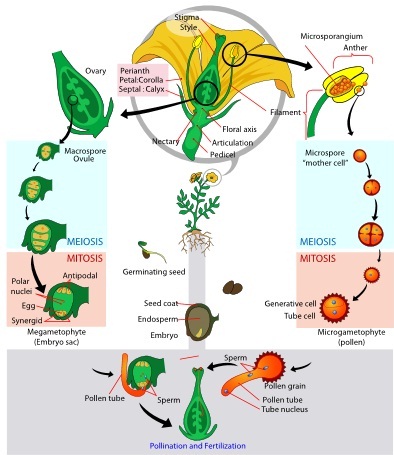Reproduction
Like all plants, dill has an alternation of generations, and
its dominant phase is the diploid sporophyte (the plant that you
usually see). Dill, being an angiosperm, has unique and
specific means of reproduction. Angiosperms are unique in that they
have seed coverings, which are very important because they provide
protection and nutrition for the embryo.
Dill seeds are about 1mm wide.
This is what dill seeds look like close up!

First let’s get familiar with a couple structures that are
involved in reproduction of dill. At the bases of dill’s flowers are
ovaries, which contain ovules. The
ovules contain megaspores. (Megaspores are analogous to egg cells in
humans.) Dill also has anthers that stick off the
flower and produce microspores which become grains of pollen. (These
are analogous to sperm cells in humans.) The stigma
is a structure at the top of the style (a long
structure that resides in the middle of the flower) that functions
in “collecting” the pollen via pollinators. The pollen tube,
located inside the style, functions in carrying the pollen to the
ovule inside the ovary.

Now let’s talk about the process of reproduction in dill. The
megaspores and microspores are produced through meiosis. The
microspores then undergo mitosis to form grains of pollen, which are
discharged at the top of the anthers. This is where pollinators such
as bees, butterflies, and moths come in. When these pollinators land
on the flowers of the dill plant to obtain food, they end up
collecting grains of pollen on their bodies. They then fly around to
other flowers and deposit the pollen on top of the stigma of
another flower on another plant. This creates cross pollination. Dill
can also pollinate itself; however, this is not the most
advantageous way to reproduce because it does not create genetic
variability, so cross pollination is the preferred
method.

The grains of pollen move through the pollen tube and are deposited
inside an ovule containing megaspores. The megaspores are fertilized
by the pollen that contains microspores. In angiosperms, however, a
special event called double fertilization occurs.
Not only is a zygote (2n) produced, but an endosperm
(3n) is produced as well. Endosperms are extremely important because
they provide nutrients for the seed when it comes time to grow; this
is an important
adaptation as seeds begin in the ground where they do not have
access to sunlight. Also, the seed contains 2 cotyledons, which will
become the first two leaves of the plant and produce the first
energy for the plant to grow big and tall.
There are several organisms that help aid in the reproduction of
dill. To learn about dill's interactions with other organisms, click
here!
Home
